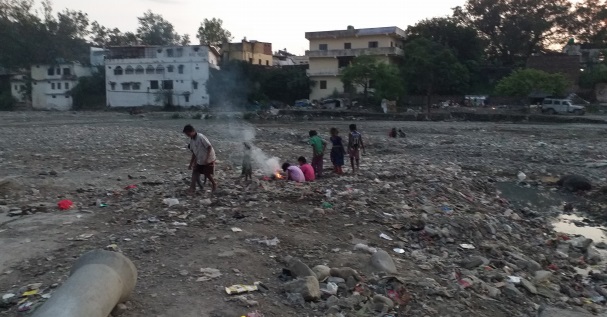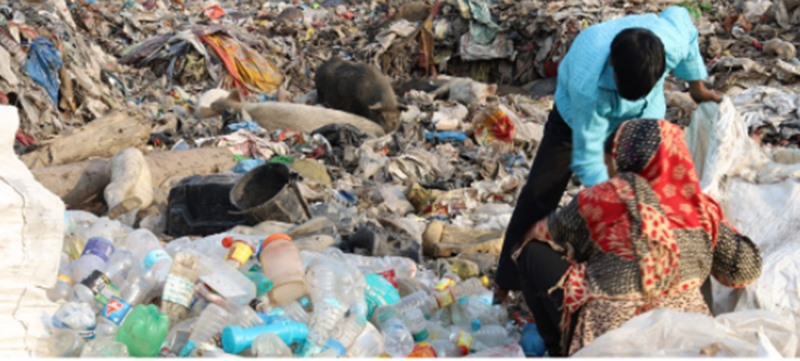Waste woes in Uttarakhand’s Haridwar and Rishikesh where up to 35% plastics waste flows into water bodies: iFOREST study
A new study points out how waste segregation suffers as 70% of households in Haridwar and 90% in Rishikesh use a single bin for waste disposal; and a large chunk of plastic waste flows into the local water bodies, including the Ganges.


Plastic waste dumped in a water body. Image used for representation purpose. Photo: Pixabay
Up to 35 per cent of the total plastic waste generated in Haridwar, Uttarakhand, leaks into its water bodies. Twenty kilometres to the northeast from Haridwar, the situation in Rishikesh town is no different where up to 30 per cent of the total plastic waste generated finds its way into the water bodies.
These are some of the important findings of a recent study to quantify the composition of solid and plastic waste in Indian cities and municipal areas. The study has been conducted by Delhi-based environmental organisation International Forum for Environment, Sustainability & Technology (iFOREST), which sampled 394 households and 89 commercial establishments in Rishikesh, and 383 households and 91 commercial establishments in Haridwar.
Apart from flowing into the water, over 13 per cent of the plastic waste in Haridwar is burnt whereas 19 per cent of this plastic waste is ‘unmanaged’. Similarly, in Rishikesh, nine per cent of total plastics is unmanaged and 10 per cent is burnt, noted the study titled ‘Baseline Assessment Study on solid and plastic waste in Haridwar and Rishikesh’.
“Plastic waste generation and its mismanagement is one of India’s biggest environmental challenges currently. The changing lifestyle in both urban and rural areas is escalating the problem. However, there is a lack of adequate data on solid and plastic waste generated from our cities,” reads the press statement issued by the non-profit.
Also Read: The Pandemic and Pollution: Handling the packaging waste of increased online shopping

Problem of source segregation
Rishikesh and Haridwar are twin holy towns on the banks of the Ganges and their waste generation and management practices are significant for Ganga rejuvenation, noted the non-profit while releasing the report three days back on July 16.
Also Read: Project to rejuvenate six rivers in Kumaon, Uttarakhand cleared
The report was released by Member Secretary of the Central Pollution Control Board (CPCB), Prashant Gargava who stressed on the need to bring in the behavioral change for managing waste problems for both businesses and people.
The report shows plastic constitutes a major portion of dry waste component in both the cities — 37 per cent in Rishikesh and 31 per cent in Haridwar.

The iFOREST study pointed out that a major challenge of waste management is segregation at source. Around 70 per cent of households in Haridwar and 90 per cent of households in Rishikesh use a single bin for waste disposal.
“Changing people’s attitude and redesigning the waste collection infrastructure will be important to ensure source segregation. Decentralized waste processing systems is missing in both the cities,” reads the statement.
In managing this high value plastic waste, informal waste collectors play a key role. However, the low value plastics such as low density polyethylene (used in manufacture of grocery bags and plastic wrap) and multi layer plastics (MLP) which constitute approximately 70 per cent of plastic waste are of major concern, stresses the study.

The report, prepared in collaboration with Deutsche Gesellschaft für Internationale Zusammenarbeit (GIZ), is part of the ongoing initiative of Project Aviral to reduce plastic waste in the Ganges funded by the Alliance to End Plastic Waste.
What can be done?
For effective and sustainable waste management in the cities, developing waste data inventory management systems and institutional strengthening are needed, suggested the iFOREST study.

“Both poor data and lack of a sound methodology to develop the waste inventory is the biggest challenge for waste management. Experience worldwide shows that developing a waste management system without an accurate inventory is like ‘shooting in the dark’,” Chandra Bhushan, chief executive officer of iFOREST said at the virtual launch of the report.
“Therefore, it is high time that we develop such methods, strengthen our institutions and implement the regulations of waste management effectively,” he added.
“CPCB is putting a lot of emphasis on Extended Producer Responsibility to tackle the issue of plastic waste, particularly Multi-Layer Packagings. We are trying to tackle the problem throughout the value chain,” said Gargava at the virtual event. He also emphasised on the need to harmonise the inventory methodology so that variation in data being received from different municipalities can be standardised.

